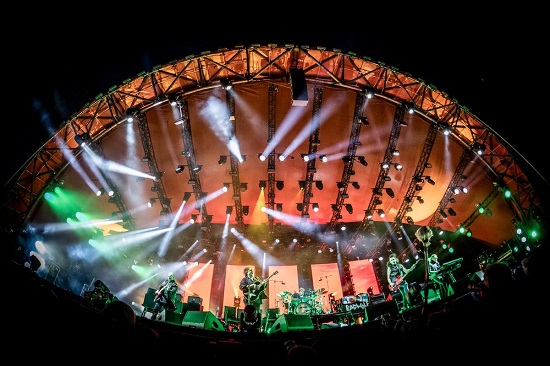The Cure at Roskilde, photo by Kim Matthai Leland
When Stormzy was announced as a Glastonbury headliner, for those of us that had been at Roskilde the previous year there was no doubt whatsoever that the set would be as crucial as it indeed turned out to be. He played the enormous Arena Stage there in 2018 to a ridiculously large crowd, a titanic set of purpose and power that, although not instilled with the same sense of era-defining occasion as that Pyramid Stage gig, showed his magisterial qualities as a live performer in force.
All of which is to say two things. Firstly that Danes go absolutely nuts for grime – see Skepta’s similarly sweaty Wednesday night set on the same stage this year – and secondly that Roskilde is a festival that does very interesting things indeed with its gigs. Unlike many events of its size (massive), it doesn’t ram its schedule to the rafters, with three or four headliners getting the chance to truly express themselves over an extended period of time, but allows the space, time and world-class production for artists of every stripe to prove their chops. Furthermore, there’s something uniquely enthusiastic about the Roskilde crowd – whether grime, hip-hop, rock, pop, indie, metal or music at its most experimental, whether among 100,000 in front of its famous Orange stage, or as part of a comparative handful in the head-mangling darkness of Gloria’s converted cowshed.

Aldous Harding, photo by Steffen Joergensen
In a way, all of the following can be considered ‘headliners’ across the four days tQ is in attendance: Bob Dylan, Cardi B, Skepta, Christine & The Queens, MØ, Robert Plant, Travis Scott, Wu-Tang Clan, Robyn, Janelle Monáe, Behemoth and The Cure, and all of them that we catch are able to seize their opportunity and then some. Apart from Dylan that is, whose Wednesday set is tedious in the extreme. His songs, however much affection this writer holds for them, are all played as the same muddy blues track, as traditional as a pub covers act, with Dylan behind his piano looking twice as bored as we are. As Robert Plant proves later in the week, just because you’re an artist of 50 years’ experience, doesn’t mean you have to phone it in. His gig is loaded with charisma, as well as gloriously pompous fiddle solos, endless drum fills, the correct helping of Zeppelin classics, and even a tribute to the black American artists he’s been, erm, “inspired by” over the years.
The Cure are excellent too. Still traumatised by memories of a set at Reading Festival in 2012 so endlessly glum we were driven to watch Sleigh Bells after thirty minutes, the two and half hours carved out for Robert Smith and co. on the very last night make for an intimidating prospect. For some of the crowd this is their eighth night of partying; before the main site opens on Wednesday there are four preliminary days of raves and local bands, set among the Mad Max-style settlements on the festival’s outskirts where wonky wooden fortresses and compact home-made bunkers boast competing soundsystems in the so-called ‘Dream City’. That is to say, of the 100,000 people sprawling in front of The Cure, the majority are more than a little fatigued.
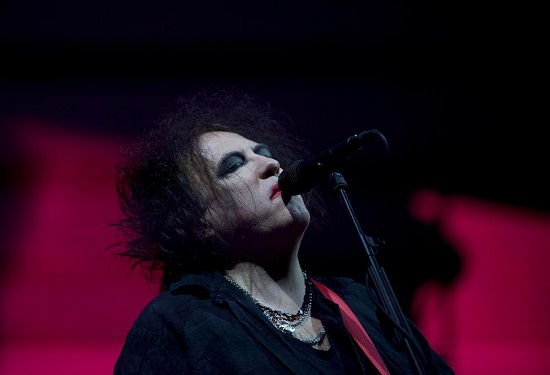
The Cure, photo by Kristian Gade
What’s brilliant, then, is that across the band’s 27 songs, there’s a certain breeziness that makes the gig all the more transformative. There’s swarming gloom and cascades of glistening melancholy, but a lightness of touch and a glimmer of humour that makes a perfect flourish to their masterful showcase of emotive and uncompromising songwriting. Not only that, the festival’s grand finale serves as a memory bridge between many a tear shed in a patchouli-oil stained 80s bedroom and those winsome humble-brags poured into our handheld devices. Robert Smith must surely realise he’s the Gandalf of the Emoticon Scene, a trusted, blessed elder who can channel the emotional resonance of tracks like ‘In Between Days’, ‘The Caterpillar’ and ‘Primary’ to a new reality.
For a big festival, Roskilde is a surprisingly sensual, gratifying experience. There are informed and open debates on feminism and social activism in the cupola known as House of Chroma that are actively stimulating. Further, they feel tangibly linked to the programming; not some kind of vaguely well-meaning, socio-cultural sop. On a more personal level (and as our homage to some excellent catering choices), team Quietus seeks solace in multiple rounds of the magnificent flæskesteg pork sandwich, replete with gravy and red cabbage, between many a show. Still, the music is the midwife. And here Roskilde plays the act of sonic herald perfectly, presenting a deft mix of weird-but-accessible acts to turn on the inquisitive, as well as the well-known names to reassure those wanting an undemanding fag, pint and a boogie.
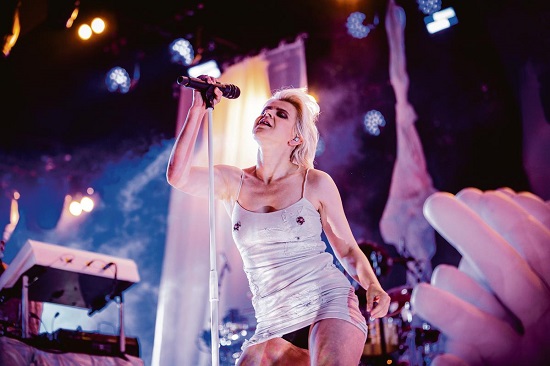
Robyn, photo by Christian Hjorth
The two sides are seen by comparing Gloria with the Orange stage. In the gloaming of Gloria, where angular shards of LED screens show abstracted blown-up visuals of what’s happening on the weird, semi-hexagonal stage beneath them, the brilliant Crack Cloud knock out a mercurial and snappy set that pulverises a curious audience into new shapes. Their rhythmic, multifaceted, ultimately futuristic sound reminds this reviewer of lost Dutch post-punk legends, Nasmak. Astrid Sonne also deconstructs the public’s sense and sinew with a performance that incorporates violin jams, bamboozling electronic deconstructions and weird takes on dance; a display of intelligence and wit set to music. Later on, Yves Tumor and band loudly channel Mick Ronson, Eddie Hazel, Gloria Gaynor and “Sweet” Charles Sherrell, in a blisteringly hot display of intent.
By contrast, standing in a municipal park on a damp, chilly afternoon watching a 70-something run through a series of half-familiar hits could sound like an occupational hazard best avoided, especially after Dylan’s opening night dirge. Luckily it’s Jorge Ben Jor on the Orange stage this time around. With a Dallas Cowboys sticker on his Telecaster and a Denmark scarf wrapped around his neck, the old master guides a supremely talented band through a cavalcade of samba rock and Sun-Ra style deconstructions; work-outs that, at times, sound as if someone has dropped an electric whisk on the kitchen floor. Still, the sensuous ‘Mas Que Nada’ floats across the sodden greensward, its elegant spirit quietly wooing the steaming crowd. People who are passing through, snack in hand, stop to watch mid-chomp. And adding a fizzy rendition of ‘Taj Mahal’ (with its glorious ska-like “bump”) and the pleasing Tropicália of ‘Take It Easy My Brother Charles’, it’s a set that only cements Ben Jor’s formidable reputation as one very smooth fellow.
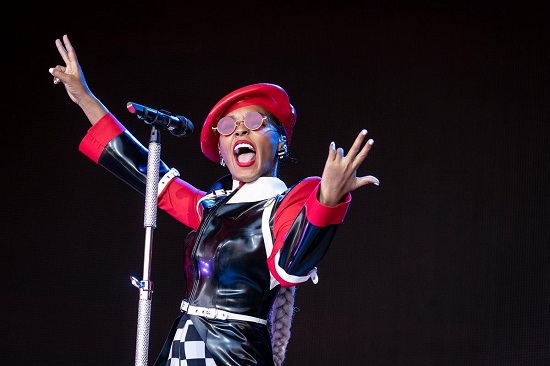
Janelle Monáe, photo by Steffen Joergensen
Through each of these remarkable sets, every one different from the last, there is one constant – that unbridled Danish determination to have a good time. At Apollo, a brutalist mini-arena, the sheer joy of Roskilde bubbles over. It’s here that the most fun is had – in front of SOPHIE’s titanic electronic judders, or The Comet Is Coming’s ferocious intergalactic jazz voyage into the early hours of the final morning. Flohio overcomes early technical difficulties for a raw display of the talent and charisma that’s set her apart as one of UK hip-hop’s new outliers, and Lizzo draws a colossal crowd, with a a luminous, rumbustious performance that could leave you mystified if you’re not immersed in the vibrant exchange between crowd and singer.
Further afield still, black midi continue their ascent as one of the world’s most exciting new bands with yet another progressive step. It’s the fourth time this writer’s seen them in the space of six months, and just a few weeks since the last, but every time they play there’s an evolution. As ‘Bmbmbmbmbm’ lurches into view, each intermittent rush of guitar grinding like an earthquake, the several hundred spectators at the Pavillion stage offer militaristic grunts in time that inject a character of the crowd’s own into black midi’s amorphous, always-shifting atmosphere.
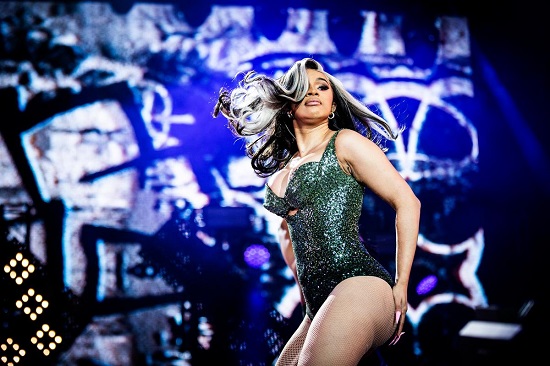
Cardi B, photo by Christian Hjorth
The same stage sees searing late-night jazz from Sons Of Kemet, with plunging grooves of sax and brass propelled by kind of rhythmic fury that only four drummers at once can hurl forth. Elsewhere there’s deft and artful folk-pop from Aldous Harding that cuts through an early-afternoon haze, a glitzy, high-energy glimpse into the glorious future of the boy band from Brockhampton and a gigantic set from Spiritualized that finds Jason Pierce at his most heart-wrenchingly cosmic. Rival Consoles serve up an hour of gloriously simpatico techno, full of flesh-and-blood flourishes, and gnarled ex-Pantera vets – now known as Philip H Anselmo and The Illegals – turn on the emotions tap during their tungsten-heavy set, providing many a chest thump, praying gesture and hearty thumbs up. There’s even deeply cringeworthy Danish dancehall in the form of long-standing trio Bikstok.
To put it briefly, this is an extraordinarily varied festival. Where there is this much variation musically, and where there is such a unique opportunity – practically in terms of the time everyone’s allotted, and more ephemerally in terms of the way the Roskilde crowd approaches absolutely everything with hearts wide open – there is a remarkable amount of artistic expression. It fosters an atmosphere where a set like Wu Tang Clan’s, where a perfectly enjoyable run through 36 Chambers classics morphs bizarrely into a sort of novelty act where they just play Nirvana and Cypress Hill songs to see which ones make people jump the most, becomes enjoyable, rather than frustrating in its sheer weirdness. Cardi B, who along with her hype man repeatedly refers to ‘Rock slide’ festival in ‘Denberg’, and plays barely two minutes of each song, is unabashed, ludicrous entertainment of the highest calibre. Whether they want to express something mindless and fun like Cardi and Wu Tang, something tightly wound and forward-thinking like Crack Cloud and black midi, something blissful, aggressive, happy, sad or just completely weird, Roskilde fosters exactly the environment an artist needs. In fact, it’s only Bob Dylan who doesn’t seem to be too fussed about seizing what feels one hell of an opportunity.

Sons Of Kemet, photo by Nicolai Hegelund Vilhelmsen
There are two artists above all, however, whose sets do not just thrive under these deeply emotional conditions, but create something wholly transcendent with them. The first is Robyn. It brings up feelings of a more primal sort particularly during her roll-out of ‘Dancing on My Own’, a track which has us on the verge of tears. After all, when you are stood in front of tens of thousands of Skandic teens howling (and I mean howling), ‘I’m in the corner / watching you kiss her’ back at a visibly stunned singer, you can’t be anything but moved. Robyn stops the track, shocked, before dancing around like a 14-year-old after four cans of her mum’s cider. It is a thirty second moment in time that renders a musical or socio-cultural critique of the set utterly meaningless.
And then there is Janelle Monáe. In terms of talent, in her generation of popstars she is essentially peerless; a singer, dancer, rapper, writer, artist, conceptualist and public speaker of absolutely staggering brilliance. Her production is choreographed to the most minute detail, but every swaggering step up and down the marble pyramid, topped with a throne, feels saturated with a power and meaning that is in every essence here and now. It’s direct in its message, full of love but never too saccharine, and the songs themselves are sublime. The music and performance betray the presence of a proper pop genius, but she also lets emotion become the focal point of it all. There’s pride, pleasure, defiance and rage in this performance, and at a festival like Roskilde, their power becomes magnified even further still. It is a festival that does not just run the gamut of human emotion, but elevate every facet of it. As big festivals go, there are few quite this good.

